Table of Contents
There are a number of quick wins to increase search traffic for just about any site in any niche.
But the heart and soul of any long term SEO strategy, comes from content.
So I want to show you how we increased this B2B clients monthly search traffic from 5.4k to 7.8k without building any links!

All we did was focus on
- Creating new content to fill the “content gap”
- Optimising service page content
- Fixing some technical SEO issues
All of that led to a 44% increase in monthly search traffic with zero link building.
This is how we did it…
A Closer Look At The Case Study Site
 Our B2B client specialises in a very specific industry.
Our B2B client specialises in a very specific industry.
About 12 months ago, the client came to us with new goals to expand their business.
So, we sat together and set two ambitious targets for their SEO campaign:
- Goal #1 -Increase the number of keywords in the top 10 from 2,500
- Goal #2 – Increase qualified search traffic to the site
With that in mind, our team developed a new SEO strategy to help our client increase their brand awareness and grow their business simultaneously.

The Biggest Challenges We Had to Overcome
The client operates in a constantly shifting industry but hadn’t published new content for a long time.
This was in stark contrast to their competitors who were publishing new content regularly and keeping pace with the ever changing niche.
So to combat that we needed to:
- Complete a content gap analysis
- Subscribe to relevant news/media outlets
That meant we could keep our finger on the pulse of the industry and stay ahead of the game with new high quality content.
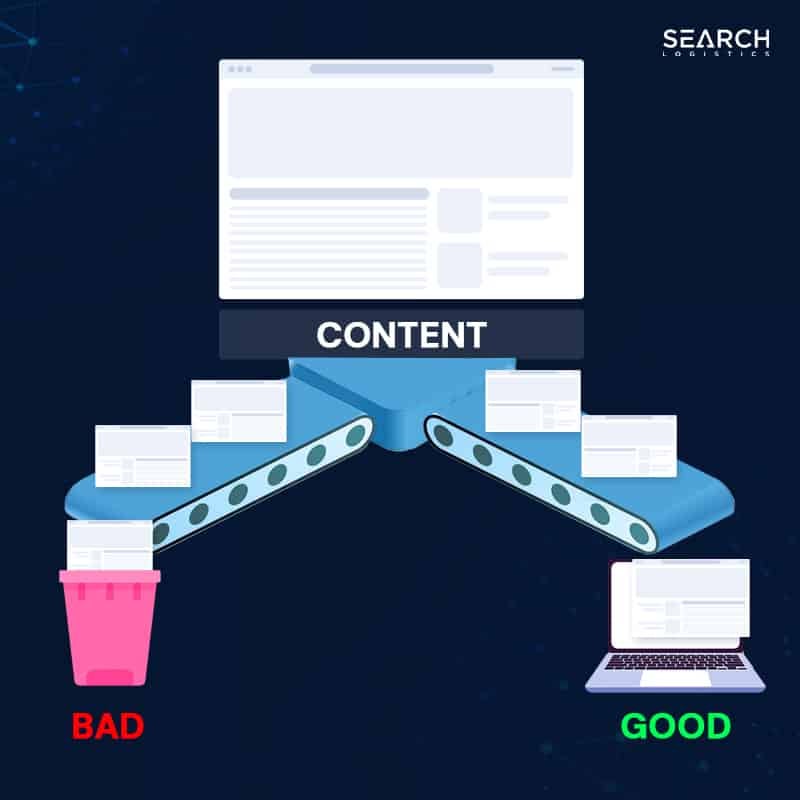
But that’s not all…
The client had added several new service pages to the site that had been struggling to rank.
This was a huge pain point because these were important money pages that generated real revenue for the client.
So, we focused on making sure that the content and on-page elements of these pages were optimised for the service-related keywords they wanted to rank for.
The final challenge was to continue improving the website’s technical elements.
The two main issues were:
- Optimising the images on the website to improve loading times
- Ensuring canonical tags were correctly implemented
This was to resolve problems related to duplicate content.
Here is a recap of the main challenges our team identified:
- Identifying content gaps between the client’s website and their competitors
- Optimising the on-page elements of the service pages to improve rankings for relevant keywords
- Improving the technical elements of the website by optimising page speed and implementing canonical tags to prevent duplicate content
Creating A Plan Of Attack
With the challenges laid out clearly, it was time for our team to create a plan of attack to address each issue individually.
Below are the exact steps we took to fix all of the issues.
Feel free to take notes for your own website. We wrote each step out clearly so you can apply them to your own site.
Step #1 – Identify Content Gaps Through Competitor Research
If you don’t have your finger on the pulse of your industry – you will get left behind.
That’s just the nature of any competitive business.
Adjusting your content to the changes in your industry is a surefire way to know that you are satisfying your visitor’s search intent.
And the proof is being rewarded by Google with higher rankings and more organic traffic.
Who doesn’t want that, right?
Finding content gaps between:
- Your website
- Your competitors
…allows you to build your keyword visibility.
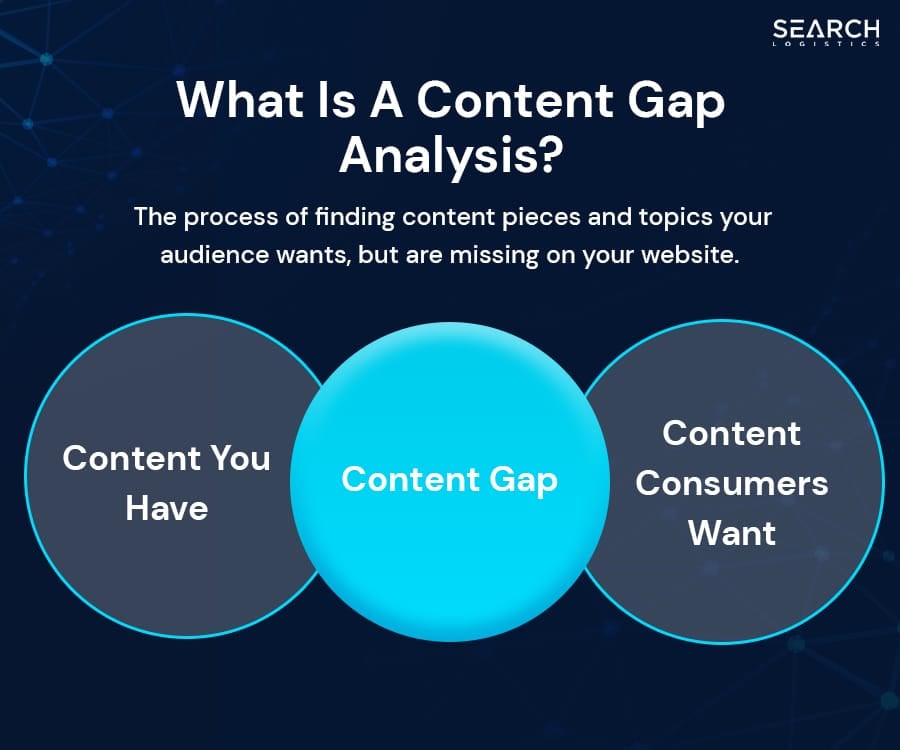
But that’s not all…
It also helps build your topical authority and expertise within your niche.
Topical authority is a holistic SEO strategy that every website owner who is serious about SEO should be using.
Here’s how to do it:
Identify Keywords And Topic Gaps Using Ahrefs
Ahrefs’ Content Gap tool shows you the keywords your competitors are ranking for, but you’re not.
Think of it like a “checklist” that points out every keyword you still need to cover.
The best part is that it’s simple to use:
Input your competitors’ domains into the Ahrefs Content Gap tool and click “Show Keywords”.

You can include up to 10 competitors, but start with your top 3-4 so you don’t get overwhelmed.
This will reveal the keyword opportunities worth targeting to bridge the gap with your competitors.
It’s worth noting that not all of these keywords will be relevant to your own website.
Make sure to filter the results and select the relevant keywords to your site.

Condense the results further by increasing the number of intersections.
Instead of just one competitor, look at the keywords where more than one of your competitors ranks.
These are the main keywords you want to target first.

We can see that the results now show just under 3,000 keywords, instead of the original 30,000.
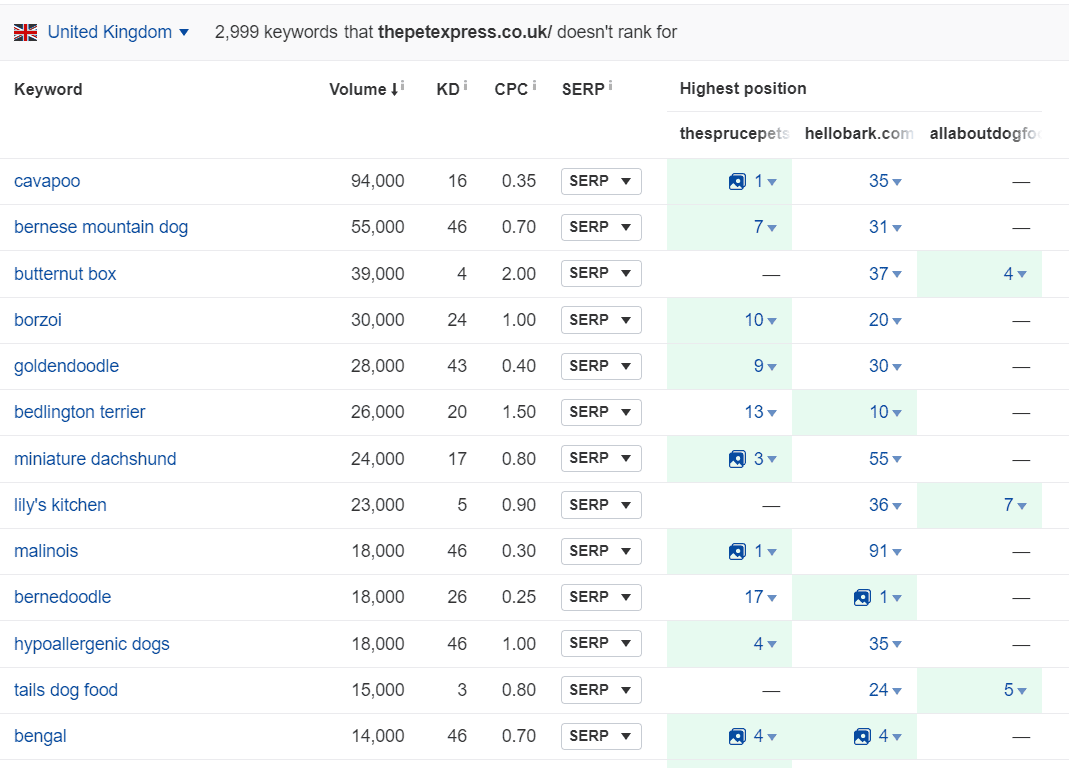
That’s a better number to work with!
Make sure you manually work your way down the list to choose keywords that best fit your website.
That will ensure you don’t miss any hidden gems.
Once you’ve identified the keywords, look at the top-ranking competing pages in the SERPs to see what you are up against.
You might already have a relevant page for the keyword – you just need to optimise.
Don’t have an existing page/post that fits the keyword?
It’s time to create a brand new page or piece of content that:
- Matches the searcher’s intent
- Is better than your competitor’s content
Find Content That You Need to Publish
Your competitors’ blogs are a goldmine for finding new keywords to target and content to publish.
Why?
Simply put:
If they rank for a keyword, you already have a blueprint of what Google is looking for.
You just need to take advantage of it!
There are two ways to get keyword ideas from your competitors:
- Perform a manual review of your competitor’s website
- Use Ahrefs Site Explorer.
Enter your competitor’s blog domain (select “path” mode) and go to the “Top pages” report.

Ahrefs shows you all the blog posts on the competing domain’s website that bring in the most traffic.
Now it’s easy to identify which topics are worth pursuing for your own blog.
Cool, right?
Step #2 – Service Page Optimisation
With the content gaps being filled in by our content writing team, it was time to focus on optimising the client’s service pages.
This was an important part of the campaign because these pages are extremely valuable to the client.
They had recently added service pages that were struggling to rank.
Note: For ecommerce stores, important pages you need to pay regular attention to are new product ranges or collection pages that need optimising in time for their seasonal peak.
Here are the three things you must pay attention to:
Start With The Basics
Ensure that on-page elements such as the:
- Page title
- H1 heading
- URL
- Meta description
… are optimised for the main keyword you want to rank for.

The page title, H1 heading and meta description should also be descriptive and engaging enough to entice users to click through to your page from the Google search results.
Identify Content Gaps On The Page
Once you’ve got the basics down, focus on optimising the content itself.
Identify the top-ranking competitors by doing a Google search for your target keyword and looking at which ones are closest to your existing page.
In our case, we looked at pages that were ranking high for the same service.
When analysing the competing pages, there are 5 questions to ask yourself:
- Does the competing page have a better outline and heading structure?
- Has the competing page included content that is missing from my page?
- Has the competing page included other types of content to enhance the page?
- Is the competing page’s content easier to read?
- Does the competing page avoid having elements that impede the user experience?
A well-structured page improves Google’s understanding of the content and makes it much easier for users to find what they want.
This can be anything from entire sections to a frequently asked questions section.
Check if they’ve included high-quality images, video embeds, tables, charts, a table of contents or infographics.
Sometimes, it’s as simple as your competitor’s content being easier to scan, read and consume.
This includes elements like too many ads or CTAs (calls to action) on a page that disrupt the flow and increase the chances of users leaving.
Identifying the gaps in your content can be the difference between ranking on page 1 and not at all.
Google is all about a quality user experience – so keep that in mind.
Consider Other Factors
Apart from the content, there may be other areas that you need to optimise to outperform your competition.
This may include:
Indexing issues
It’s always worth doing a simple check to ensure that your page is crawlable and indexable by Google.
Go to Google and do the following search:
site:yourdomain.com/your-page/
If your page doesn’t show up, then it’s not indexed.
Ensure that it isn’t blocked by your robots.txt file, is present on your XML sitemap and doesn’t include a noindex tag in the source code.
Structured data
Structured data (or schema markup) is code that allows Google to understand specific elements on your page.
It also increases the chances of ranking as a featured snippet.
You can check whether the competing page has included structured data using any of these schema testers.

Make sure you follow our complete rich snippet guide to give your website the best chance of winning a featured snippet.
Internal linking
Google uses internal links to find and index new content on your site.
Internal linking is a powerful tactic that you can use to guide the search engine’s crawlers towards your pages whilst also improving the overall navigation of your website for users.
Win-win.
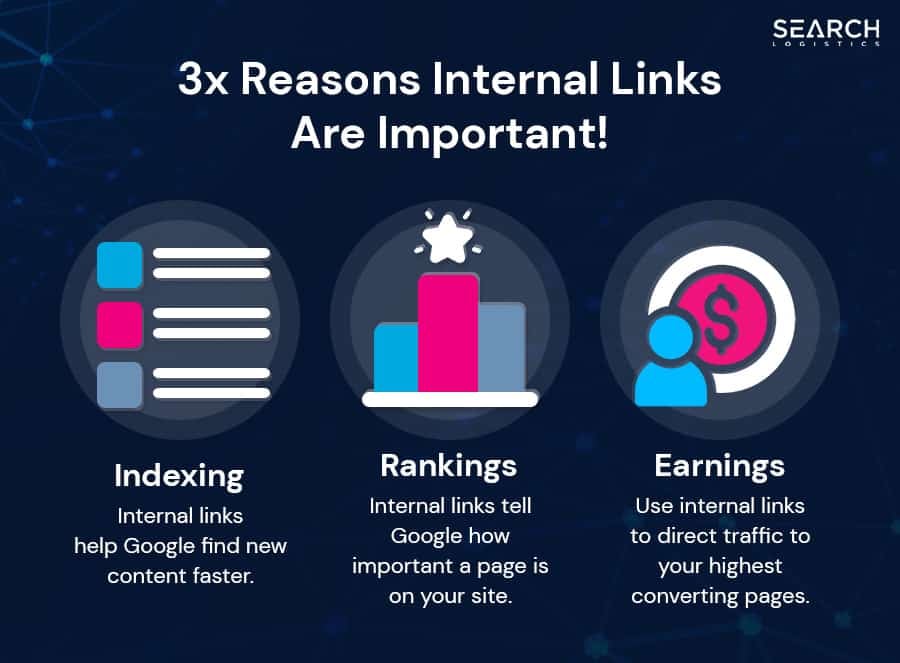
Add internal links from other relevant pages on your site to the one you are optimising. Make sure you use keyword-rich anchor text for the links.
Need help with internal linking?
Check out our complete internal link building tutorial to get this underrated tactic working for your site.
Step #3 – Fixing Technical Issues
The final issue we needed to address was fixing technical issues preventing the site from ranking to its full potential.
Yes, ranking potential is a real thing.
And it can be the difference between thousands of visitors per month.
We conduct a full technical SEO audit on each of our client’s sites every 6 – 9 months. It’s the only way to be sure that each client’s site is optimised correctly.
Most website owners don’t bother with this and it can really cause some damage in future Google updates.
Being lazy now will impact your results later.
During our most recent audit for our client, we found two essential areas that needed to be addressed:
- Image optimisation
- Canonical tags
Here’s how to fix them both.
Image Optimisation
Big images slow down your website speed.
Our client had hundreds of images over 100 kb in size, costing them tons of time in page load speed.
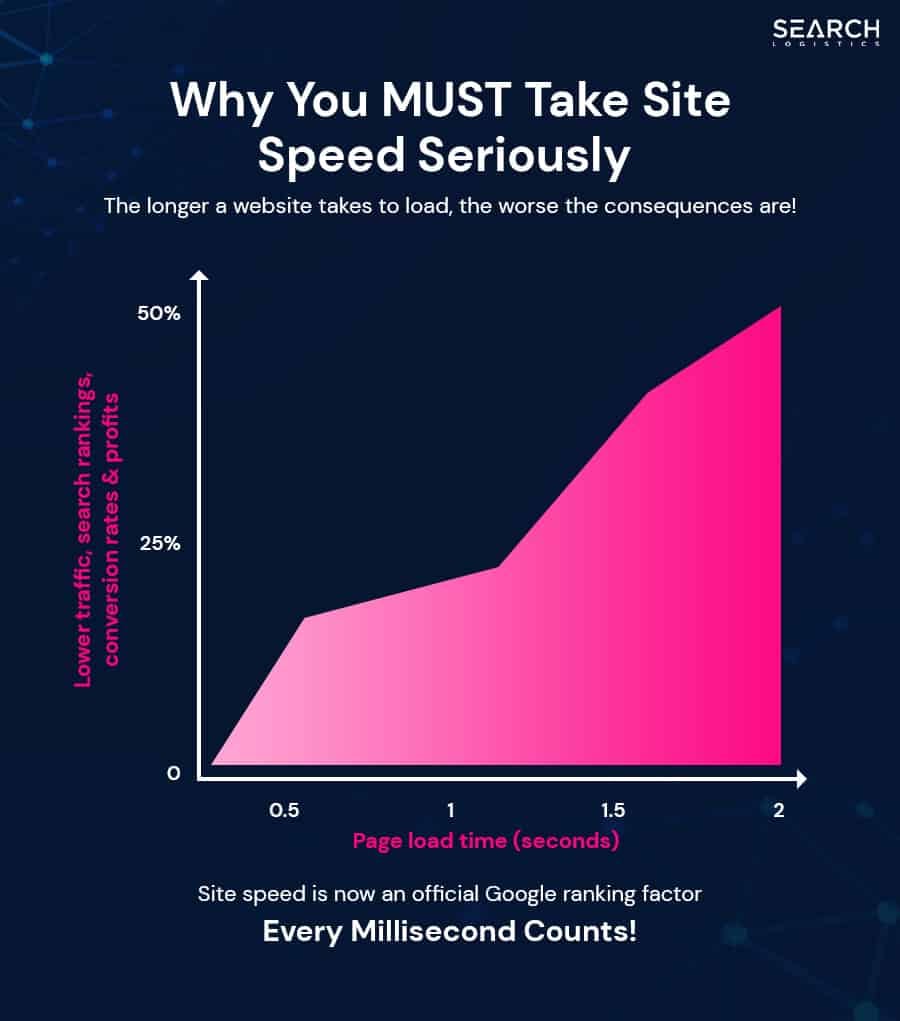
There are two techniques that you can use to reduce the loading times of images:
- Compression
- Lazy loading
We recommend using both if you are serious about improving your website page load speeds.
The best part?
You don’t need to manually do anything. There are a number of tools and plugins that will take care of it for you.
Image Compression
You want to compress your images to load quicker, but you don’t want to damage the image quality.
There are a ton of image compression tools available online. But there are only a few we can confidently recommend:
- GIMP – A downloadable image editor
- TinyPNG – Uses lossy compression techniques to reduce the file size of both PNG and JPG files
- Smush – Image compression and optimisation plugin for WordPress
- Imagify – An online tool and WordPress plugin for image optimisation
Look at each of them and choose what works best for your site.
Each tool is designed to take the hard work out of image compression!
Lazy-Loading Images
Next is lazy-loading the images on the site.
Think of lazy loading as a way to show your images to your site visitors when they need them.
As the visitor scrolls down the page, the images gradually load in.
This means that visitors don’t have to wait for all images on the page to load before they start reading your content.

Pretty cool, right?
Lazy load also helps to:
- Reduce unnecessary network requests
- Conserve bandwidts
Make sure you check out our complete increase website speed tutorial to learn more about lazy loading images and speeding up your website in general.
Canonical Tags
Next up was to fix the Canonical tags.
These tags can be a pain to deal with if you don’t take the time to understand what they are or how they work.
Canonical tags are a type of HTML element used to prevent duplicate content issues in SEO.
They inform search engines which version of a page to prioritise or consider as the “master” when multiple versions exist.

This ensures search engines understand which page to index and rank in the search results.
Canonical tags also help reduce ranking signals and avoid potential penalties for duplicate content.
As you can see – they are pretty important!
This is what a canonical tag looks like:
<link rel=”canonical” href=”https://www.example.com/preferred-url”>
Feeling overwhelmed?
Don’t be. It’s simpler than it might first seem.
Let’s break down the elements of a canonical tag:
- <link>: This is an HTML tag used to define a link between the current web page and another resource. In the case of a canonical tag, it establishes a relationship between different versions of the same content.
- rel= “canonical”: The rel attribute specifies the relationship type between the current page and the linked page. In this case, the value “canonical” indicates that the linked page is the preferred or canonical version.
- href= “https://www.example.com/preferred-url”: The href attribute specifies the URL of the preferred version of the webpage. It should point to the specific URL that you want search engines to treat as the primary version.
Not so difficult, right?
When implementing canonicals, here’s what you need to do:
- Use accurate and consistent URLs:
- Remember to add self-referencing canonical tags:
- Use unique canonical tags:
- Proper implementation across duplicate content:
- Carry out regular audits:
Ensure that the canonical tag points to the correct, canonical version of the page. The URL should reflect the preferred URL that you want search engines to index and rank. Ensure that all variations (such as HTTP vs. HTTPS, www vs. non-www) consistently use the same canonical URL. This avoids diluting the canonical signal and potential confusion for search engines.
Each page should have a self-referencing canonical tag. This means that if a page is the preferred version itself, the canonical tag should point to its own URL. This helps reinforce the canonical signal and avoids confusion.
Each page should have a unique canonical tag. Avoid using the same canonical URL for multiple pages, as it can lead to incorrect indexing and cause confusion as to which URLs are actually similar or not.
Canonical tags should be implemented on all versions of a page with duplicate content, including similar or alternate versions (such as pagination or printer-friendly pages). This helps consolidate ranking signals and avoid duplicate content penalties.
Conduct periodic audits to ensure that canonical tags are correctly implemented and functioning as intended. Check for any implementation errors, such as missing or incorrect tags.
If you need more information, check out our full canonicalization article.
It has everything you need to better understand canonical tags and how to use them for SEO.
The Results Are In
Over the past year, we exceeded our goal by increasing monthly search traffic from 5.4k to 7.8k.
That’s 44% growth without building any links:

Likewise, the site is now ranking for 6,694 keywords in the top 10 pages of the search results compared to 2,532 last year – representing an increase of 164%.

The client was super happy and so was our team!
These are big results considering the nature of the client’s industry and how competitive it was.
Click Here To Learn More About What We Do
Wrapping It Up
Here’s the takeaway:
SEO is a long-term marketing strategy.
It usually takes about 9-12 months before you start to see an ROI.

But the payoff is worth it.
The key is to focus on holistic SEO strategies that are proven to stand the test of time. The most significant factor in this case study was creating great content to fill in content gaps.
As a recap, here are the 3 main steps our team took to deliver these results:
- Identified content gaps with a competitor analysis and created great content to fill those gaps
- Optimised the core service landing pages on the website so they ranked in the top positions on Google
- Fixed the technical SEO issues on your website, which included optimising images and implementing canonical tags to avoid duplicate content issues
The best part is each of these steps is universal.
That means you can take and apply them directly to your own website to achieve similar results.
Need help with the SEO for your own website? Get in touch with us here.

